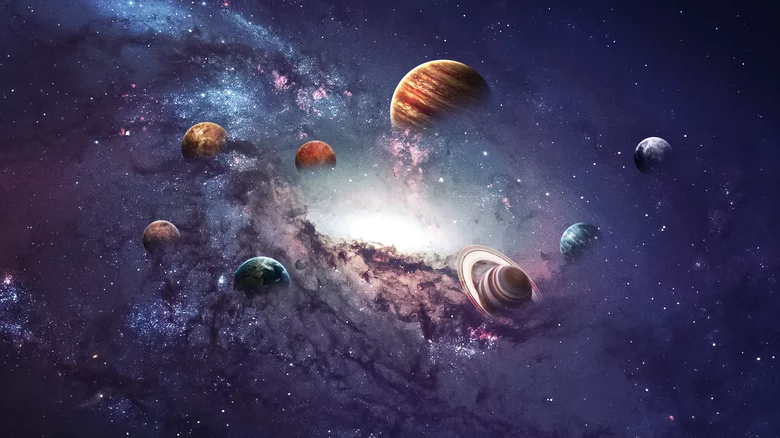
Universe
The universe includes all the matter and energy that exists. It includes the Earth and all other plants, stars, galaxies, and all that they contain. The entire cosmos, from the smallest particles on Earth to the largest galaxies in space, is the universe.
Color:
The color of the universe was identified by astronomers at the Johns Hopkins University, United States. Initially, the color was thought to be greenish-white- but later it was confirmed as beige.
Composition:
The universe is composed of dark energy and dark matter; It consists of 73 percent dark energy and 23 percent dark matter. The remaining 4 percent consists of atoms. The elemental composition of the universe is around 78 percent hydrogen and 20 percent helium. The remaining 1 percent is composed of other chemical elements.
Origin:
The origin of the universe dates back to around 15 billion years. Our universe originated as a dense cloud of gas that expanded rapidly outwards. It was made up of hydrogen and a small amount of helium. In the beginning, the stars and the planets were absent. The first stars came into existence when the universe was around 100 million years old.
The universe was created during a cosmic explosion called the Big Bang that occurred between 10 to 20 billion years ago. Before the Big Bang, all matter that exists in the present-day universe was condensed into a tiny area. After the explosion, the matter scattered as dust, cloud or mist all around.
Age:
The age of the universe refers to the time that has elapsed since the Big Bang explosion. Scientists estimate the age of the universe to be around 10-20 billion years old.
Methods to estimate the Age.
There are various ways to determine the age of the universe. The three most common ways are
- By finding the age of the age of the chemical elements
- By determining the age of the older star
- By determining the age of the oldest white dwarf
The age of the universe can also be estimated from a cosmological model based on the Hubble constant and the densities of matter and dark energy.
Constellations
Constellations are patterns of stars that can be easily identified. A constellation can also refer to a region in the sky with a specific group of stars. There are 88 constellations in the sky.
Every year, the sun passes through an imaginary ring of 12 constellations in known as the ZODIAC. Ptolemy named the constellations of the Zodiac in the 2nd century BC.
- Aquarius; – The water bearer
- Aries; – The ram
- Cancer; – The Carb
- Capricorn; – The goat
- Gemini; – The twins
- Leo; – The lion
- Libra; – The scales
- Pisces; – The fish
- Sagittarius; – The archer
- Scorpio; – The scorpion
- Taurus; – The bull
- Virgo; – The virgin
Stars
Stars are extremely large gaseous bodies found in the universe. They produce enormous amounts of light and other forms of energy through nuclear fusion. The Sun is the star closest to the Earth.
Stars vary in their shape and size. Some such as neutron stars have a radius of only about 10km, while some such as the Pistol Star are 100 times bigger than the Sun.
Nebulae
A nebula is a cloud of dust particles and gases in space. The word nebula is derived from the Latin word for clouds. Nebulae are among the most beautiful objects in the universe. Stars are born in Nebulae. The
Stars make them glow with rich colors. A nebula is composed of about 90 percent hydrogen, 10 percent helium, and 0.1 percent heavy elements, Nebulae are divided into
- Emission nebula
- Dark nebula
- Supernova remnant
- Crab nebula [1]
- Planetary nebula
- Ring nebula [2]
- Stellar nurseries [3]
- Reflection nebula
Galaxy
A galaxy is a huge collection of stars, dust, and gas. Galaxies are found in single or large groups called superclusters. It is believed that more than 100 billion galaxies are scattered throughout the universe.
All galaxies do not look alike. They vary greatly in shape and size. Based on their shape and appearance, galaxies can be divided into three broad categories …Spiral, elliptical, and irregular. Galaxies can range from a few thousand to half a million light in size. All the stars that we see in the night sky belong to the Milky Way Galaxy.
Examples: –
- Elliptical Galaxies
- Spiral Galaxies
- Irregular Galaxies
- Dwarf Galaxies
- Andromeda Galaxy
Black Hole
Black holes are extremely dense celestial bodies (regions in space) that have a strong gravitational force. The gravitational force of a black hole is so strong that nothing can escape, not even light. A black hole is formed when massive stars collapse under their own gravitational force.
The concept of black holes was proposed by Albert Einstein, in his Theory of General Relativity, in 1915. The term “Black hole” was coined by John Wheeler, an American scientist, in 1968. Wheeler used the term in a lecture at the American Astronomical Society.
- Formation of black holes
- Singularity
- Event horizon
- Schwarzschild black hole
- Middleweight black holes
- Kerr black holes
- Roy Patrick Kerr
- Reissner – Nordstrom black hole
- Wormhole
- Supermassive black hole
Milky Way
The Milky Way Galaxy is home to our solar system. It includes thousands of clusters of stars and nebulae. The galaxy can be seen as a faint band of hazy white light in the night sky. It has a diameter of about 1,00,000 light-years and is very massive.
The Milky Way is a spiral galaxy and has about 200 billion stars. It has six spiral arms, four major and two minors, coiling around the central elliptical bulge. The arms twirl out from the This center of mass is called the galactic center.
Solar System
The solar system is a group of celestial objects located in the Milky Way Galaxy. It is made up of eight planets. Astronomers believe that the solar system is around 4.5 billion years old.
The solar system is about 25000 light years from the center of the Milky Way Galaxy. The solar system is elliptical in shape and has the sun at its center. The solar system is always in motion. All the planets and celestial bodies move around the sun in elliptical paths
Asteroid and Meteoroid
Asteroids are small rocky bodies that resemble planets. They are also known as minor planets or planetoids. Asteroids orbit the Sun like all planets. Most asteroids are found in a region known as the asteroid belt between the orbits of Mars and Jupiter.
Meteoroids are smaller than asteroids. They are small pieces of metallic debris. Most of them are even smaller than a pebble. Meteoroids move around the Sun in varying orbits and speeds. Most meteoroids burn up when they enter the Earth’s atmosphere.
Comets
Comets are small extraterrestrial objects made of ice and dust. They look like stars with a long tail trailing behind. Millions of comets move everywhere around the solar system.
Comets enter the solar system and move around the Sun in highly elliptical orbits. Their orbits often extend out of the reaches of the solar system. They often go out of the solar system and come back after thousands of years. Most comets are too small or faint to be seen by the naked eye. A few can be seen through telescopes. Some become visible to the naked eye when they pass close to the Sun.
Eclipse
Eclipses are astronomical events or effects. The word eclipse is derived from the Greek word eclipse meaning “cease to exist”. Eclipses occur when either the Moon or the Earth blocks out of the Sun’s rays thereby creating shadows on either the Moon or the Earth.
There are two kinds of eclipse, solar eclipses and lunar eclipses. Eclipse can be total or partial. In a total eclipse, one celestial body is completely blocked from view by another celestial body. In a partial eclipse, only a part of a celestial body is blocked from view by another celestial body.
Famous Astronomers




Caption: https://media.nature.com/lw767/magazine-assets/d41586-018-05458-6/d41586-018-05458-6_15845006.jpg


Caption: https://i.guim.co.uk/img/media/b36ce1d3e4122c3d9ea61aae97435427a2be6db7/0_314_3356_2014/master/3356.jpg?width=1200&height=1200&quality=85&auto=format&fit=crop&s=60ab4090e8670420d755b58c39ab63b4

References
[1] https://en.wikipedia.org/wiki/Crab_Nebula
[2] https://en.wikipedia.org/wiki/Ring_Nebula
[3] https://en.wikipedia.org/wiki/Stellar_nursery
[4] Public Library Book
[5] Universe – D. Gunasena and Company Limited (First Edition 2012)


